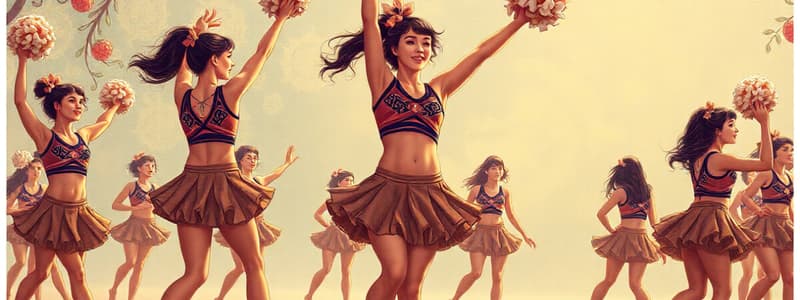Podcast
Questions and Answers
What is a central characteristic of hip-hop dance?
What is a central characteristic of hip-hop dance?
- Strictly choreographed routines with no room for variation
- Focus on synchronized group performances
- Improvisation that allows for personal expression (correct)
- Formal training in classical dance techniques
In which decade did hip-hop dance primarily originate?
In which decade did hip-hop dance primarily originate?
- 1980s
- 2000s
- 1990s
- 1970s (correct)
How does hip-hop dance relate to music?
How does hip-hop dance relate to music?
- Musicality connects movements to the beats and rhythms (correct)
- Movements are often dictated by the lyrics of the song
- Movements ignore the music and focus only on form
- Dancers typically perform in silence to highlight their movements
What aspect of hip-hop culture has influenced hip-hop dance?
What aspect of hip-hop culture has influenced hip-hop dance?
What distinguishes hip-hop dance from many other dance forms?
What distinguishes hip-hop dance from many other dance forms?
Which hip-hop dance style is characterized by rapid muscle contractions creating a popping effect?
Which hip-hop dance style is characterized by rapid muscle contractions creating a popping effect?
What is the primary purpose of Krumping in hip-hop dance culture?
What is the primary purpose of Krumping in hip-hop dance culture?
Which of the following is a key movement in the locking dance style?
Which of the following is a key movement in the locking dance style?
What distinguishes waacking from vogueing in dance?
What distinguishes waacking from vogueing in dance?
Which element of hip-hop dance refers to the spontaneous creation of movements during a dance-off?
Which element of hip-hop dance refers to the spontaneous creation of movements during a dance-off?
Flashcards
Modern dance technique: Contraction and Release
Modern dance technique: Contraction and Release
A dance technique focusing on torso movements, connected to breathing.
Hip-hop dance origin
Hip-hop dance origin
Emerged in urban communities like the Bronx in the 1970s.
Modern dance themes
Modern dance themes
Modern dance often explores complex human emotions and social issues.
Hip-hop dance: improvisation
Hip-hop dance: improvisation
Signup and view all the flashcards
Modern Dance: Isadora Duncan's influence
Modern Dance: Isadora Duncan's influence
Signup and view all the flashcards
Breaking (Breakdancing)
Breaking (Breakdancing)
Signup and view all the flashcards
Popping
Popping
Signup and view all the flashcards
Locking
Locking
Signup and view all the flashcards
Krumping
Krumping
Signup and view all the flashcards
Hip-Hop Dance Cypher
Hip-Hop Dance Cypher
Signup and view all the flashcards
Study Notes
Cheerleading History
- Cheerleading originated in the 1860s in Great Britain, entering the US in the 1880s.
- The term "cheerleading" is coined from the words "cheer" and "dance."
- "Cheer" is the act of motivating and boosting the morale of a team.
- "Dance" is used to express emotion and gestures during performances.
- Princeton University, in 1884, developed crowd chanting for sporting teams to promote school spirit.
- Thomas Peebles created the yell "Sis Boom Rah!" in 1884.
- Johnny Campbell of the University of Minnesota is credited with starting organized cheering, yelling "Rah, Rah, Rah! Sku-u-mar, Hoo-rah! Hoo-rah! Varsity! Varsity! Varsity, Minn-e-so-ta!" in 1889.
- Cheerleading progressed from simply chanting to well-organized performances.
Cheerleading Benefits
- A healthy level of physical fitness, including strength training
- Coordination and flexibility improvement
- Posture improvement
- Development of teamwork and confidence
- Learning to take direction
Cheerleading Stunts
- Cheerleading stunts involve three positions: flyer, base, and spotter.
- The flyer performs the stunts in the air.
- The base holds the flyer or flyers up above the ground.
- Spotters help the flyers into the stunt and catch them to prevent injury.
Cheerleading Competition
- Cheerleading routines involve jumps, dance, and stunt sequences.
- Cheerleading routines are becoming more creative each year.
Cheerleading Positions
- Ready Position: Basic starting position where feet are shoulder-width apart, elbows at the sides, and hands clenched into fists, close to the hips.
- Fist: Common hand position for most cheer motions.
- Clap: A cheer position using a blade-like position, with the palms opened. Not as loud as a clasp.
- Clasp: Position used during chants or cheers where elbows are tucked close to body, palms cupped.
- High V: Arms extend straight up at 45 degrees with fists. Wrist straight, circles facing forward, hands slightly ahead of the body.
- Low V: Both arms extend down at 45 degrees from the body with fists and wrist straight, circles facing forward.
Cheerleading Jumps
- Beginner jumps are commonly Straight/T Jump, Tuck Jumps and Spread Eagle.
- More advanced jumps include Herkie, Side Hurdler, Toe Touch, Pike, and Around the World.
Modern Dance Key Characteristics
- A rejection of formal ballet techniques.
- An emphasis on personal expression
- A focus of emotional authenticity and the dancer's personal connection to the movement or theme.
- Techniques include contraction and release ,falls, rolls, and floor work.
Studying That Suits You
Use AI to generate personalized quizzes and flashcards to suit your learning preferences.




